Plant Physiology: Developments in Crop Science, cartea 21
Editat de J. Sebaneken Limba Engleză Hardback – 17 feb 1992
Preț: 2048.94 lei
Preț vechi: 2806.77 lei
-27% Nou
Puncte Express: 3073
Preț estimativ în valută:
392.05€ • 410.44$ • 324.41£
392.05€ • 410.44$ • 324.41£
Carte tipărită la comandă
Livrare economică 07-21 aprilie
Preluare comenzi: 021 569.72.76
Specificații
ISBN-13: 9780444986993
ISBN-10: 0444986995
Pagini: 453
Ilustrații: 1
Dimensiuni: 156 x 234 x 25 mm
Greutate: 0.81 kg
Editura: ELSEVIER SCIENCE
Seria Developments in Crop Science
ISBN-10: 0444986995
Pagini: 453
Ilustrații: 1
Dimensiuni: 156 x 234 x 25 mm
Greutate: 0.81 kg
Editura: ELSEVIER SCIENCE
Seria Developments in Crop Science
Cuprins
Preface. 1. The structure and physiology of the plant cell. Submicroscopic structure of the cell (Z. SLADKÝ). Some physico-chemical properties of the protoplast. The membrane system. Water management of a plant cell (M. PENKA). 2. Uptake and movement of water. Water, its content and function in plants. Ecological relationship of plants to water. Uptake and movement of water in plants. Water conduction in plants. Losses of water. Water balance in plants. Principles of methods of estimating the water regime in plants. 3. Photosynthesis (L. NÁTR). Introduction. Radiation. Prinicipal photosynthesizing structures. Biophysics and biochemistry of photosynthesis. Quantum efficiency of photosynthesis. Physiology of photosynthesis. Principles of measurement of the rate of photosynthesis. Historical survey of studies on photosynthesis. 4. Phloem transport (S. PROCHÁZKA). Phloem loading. Transport of assimilates through the phloem. Phloem structure. Phloem unloading. Distribution of assimilates in plants. Methods for studying transport and distribution of metabolites in plants. 5. Respiration of plants (L. NÁTR). General characteristics of respiration and its role in the life of plants. Biochemistry of respiration. Use of respiration during the life activities of plants. Rate of respiration and effects of exogenous factors. Principles of estimation of the respiration rate. 6. Physiology of mineral nutrition of plants (J. KUPKA). The movement of ions from the soil solution to the roots. The role of the root in nutrient uptake. Mechanism of penetration of nutrients into the cell. Ion transport in plant roots. Transport of ions in leaves. Factors affecting nutrient uptake. Foliar nutrition. The uptake and utilization of biogenic elements. Reutilization of elements in the plant. The uptake of nutrients during ontogenesis. Determination of the uptake and utilization of nutrients. 7. Heterotrophy (L. GRÉC). General characteristics of heterotrophic nutrition. Saprophytism, its characteristics and importance. Parasitism, its characteristics and importance. Mixotrophy, its characteristics and importance. Symbiosis, its characteristics and importance. The importance of heterotrophic organisms. Heterotrophy of wood-destroying fungi. Humus and its effects on plants. 8. Growth and growth regulators (I. MACHÁČKOVÁ). Growth stages. Exogenous factors of growth. Growth regulators. 9. Structural integrity and organization of plants. The principle of integrity (J. ŠEBÁNEK). Plant growth and correlations. Regeneration, polarity, explanantion, and transplantation. 10. Germination. Seed germination and its course (L. GRÉC). Biochemical processes during germination. Factors affecting germination. 11. Formation of flowers, fruits and tubers. Flower formation. Differentiation and the growth of flowers (Z. SLADKY´). Production and growth of fruit. Production and growth of tubers and bulbs - tuberization (J. ŠEBÁNEK). Genetic regulation of physiological process (I. MACHÁČKOVÁ). 12. Dormancy and senescence in plants (J. ŠEBÁNEK). Biological importance of dormancy, and of dormancy and phyllogenesis. The dormancy of buds. Dormancy of seeds and fruits. Dormancy of tubers and bulbs. Senescence. 13. Plant Movements. Classification of plant movements. Physical movements. Vital movements. 14. Resistance of plants to unfavourable environmental effects (M. PENKA). Deficit and surplus of water in the soil. Effect of water deficit on prinicple physiological functions. Irrigation as the most suitable method of fighting drought. Critical periods of water requirements. Resistance of plants to unfavourable temperatures. Frost resistance in plants. Hardening of plants. Measures for increasing the frost resistance of plants. Overheating of plants the effects of high temperatures. Effects of increased concentrations of salts in the soil upon plants. Resistance of plants to air pollution. 15. Physiology of the diseased plant (L. GRÉC). Infection of the host plant with the parasite. Physiological processes in the diseased plant. Immunity of the plant. REFERENCES. SUBJECT INDEX.












